If competition isn’t your thing, you can do a simpler activity at home with your dog that we call Nose Games. You can do just the easy parts – hiding treats in a room while your dog watches – or go all the way to the advanced stages, where your dog can find missing pets and people.
Not long ago we had a client in our Nose Games class with her 8-year-old son. The family’s enthusiastic 20-pound Terrier mix ultimately learned to find the boy when he hid in the woods!
In Nose Games, you teach your dog to look for and find hidden objects when you ask her to. This is an exceptionally useful activity, as it uses lots of energy and can tire out even a very active dog. Also, it has very practical applications as well – including helping shy or fearful dogs gain confidence. And dogs love it!
We start with treats, since most dogs will happily look for food. You can eventually ask your dog to look for hidden objects (such as favorite toys, or your lost keys) and even hidden or missing humans and other animals!
1. Start by “hiding” treats as the dog watches, in the dog’s plain view.
- Have your dog sit and wait/stay. (If she doesn’t know wait/stay, have someone hold her leash.)
- Walk about six feet away, show her a treat, remind her to stay, and place the treat on the ground.
- Return to her side (remind her to stay!). Turn and face the treat, then tell her “Search!” (If she won’t get up until you release her from the stay, say “Search!” and then give your release cue.) She should run right out and eat the treat. Repeat a half-dozen times.
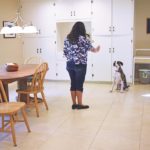

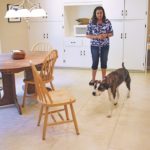
2. Next, “hide” the treats in really easy places, while your dog watches.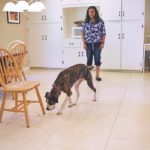
- Have your dog sit and stay. Let her watch you “hide” a treat in plain view (behind the leg of a chair, by a waste basket, etc.).
- Return to her side (reminder her to stay!). Turn and face the treat, then tell her “Search!” She should run right out and eat the treat. Repeat six or so times.
3. Ask her to sniff an item that has the scent of a treat and add a cue, such as “Scent!”
- Have your dog sit and stay. Let her watch you hide several treats in plain view.

- Return to her side (remind her to stay!). Turn and face the treats, rub one of the treats you’re using on a paper towel, hold the towel in front of her nose (don’t let her eat it!) and tell her “Scent!” (Don’t worry if she doesn’t appear to sniff it.)
- Then tell her “Search!” She should run right out and eat the treats. Repeat six or seven times, asking her to sniff the item that contains the treat scent and giving her the “Scent” cue before each attempt.
4. Hide treats in locations that require a little more effort to detect.
- Have your dog sit and stay. Let her watch you hide a treat in a harder place (behind a chair leg, etc.).
- Return to her side (don’t let her get up!). Turn and face the treat, do “Scent!”, then tell her “Search!” She may have more difficulty finding this treat. Don’t help her! This is where she starts learning to use her nose. If you help her, she won’t use her nose – she’ll learn to wait for you to tell her where it is. If she truly can’t find it, reset, and hide it in an easier spot. Make sure she watches you! Repeat a half-dozen times.
- Gradually hide the treat in harder places, having her “Scent!” before each set. “Harder” spots are on top of things, inside of other things (like a shoe, or on a shelf in a partially opened cupboard or closet), or inside open containers on raised surfaces.
- Now hide multiple treats, in easy and challenging spots. Have your dog sit and stay. Let her watch you hide two to three treats in somewhat easy places (behind a chair leg, etc.).
- Return to her side (don’t let her get up!). Turn and face the treats, do “Scent!,” then tell her “Search!” She may have more difficulty finding multiple treats. If necessary, indicate an area by spreading your arms and saying “Search here!” Don’t point to the treat! This is where she really starts using hers nose. If she truly can’t find it, reset, and hide it in a slightly easier spot. Make sure she is watching you! Repeat a half-dozen times.
- Gradually hide treats in harder spots, having her “Scent” each time before you send her.
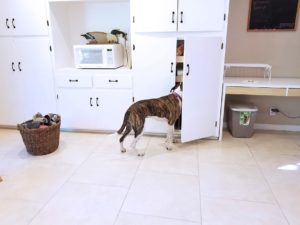
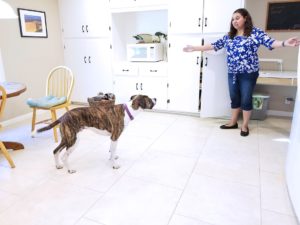
5. Hide the treats when the Dog is Out of the Room; NOW IT GETS REALLY FUN!
- Put your dog in another room. Hide two or three treats in somewhat easy places.
- Bring her back to the room, have her “Scent!” then tell her “Search!” She may have more difficulty finding multiple treats. If necessary, indicate an area by spreading your arms and saying “Search here!” Don’t point to the treat! If you help her, she won’t use her nose. If she truly can’t find it, reset, and hide it in a slightly easier spot. Repeat a half-dozen times, doing “Scent!” each time.
- Gradually hide treats in harder spots.
6. Generalize “Search” to Other Objects. Start with her favorite toy!
- Generalize her “Search” behavior to other objects as you desire,
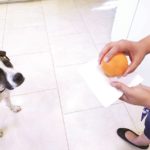 starting with a favorite toy. Rub the toy on the paper towel, and start back at Step 1, placing the toy in plain view and move quickly through to Step 5.
starting with a favorite toy. Rub the toy on the paper towel, and start back at Step 1, placing the toy in plain view and move quickly through to Step 5. - Next, use less favorite or neutral objects. For humans, rub the human’s scent on a paper towel (have them rub their neck with the paper towel). Then have the human hide, in an easy spot at first (let the dog find the human in plain view, then watch the human hide behind a barrier, or around a corner, then through Step 5.)
7. Teach your dog to perform a specific behavior that will indicate when she has found something.
- Pick a behavior that your dog already knows well, or teach her a new behavior like “Speak,” “Down,” “Touch with your paw,” etc., that you want to be the indicator behavior. Teach her a new cue for that behavior, by saying (for example) “Mark!” and then cueing the behavior.
- With your dog watching, put a treat in a box with holes in it, or out of her reach, so she can find it but not get to it.
- Tell her “Scent!” and “Search.” Follow her to the treat, and when you can tell she has found it, tell her “Mark!” and cue her indicator behavior if necessary (if she doesn’t do it on the “Mark” cue). Repeat until she starts to automatically offer her indicator behavior when she gets to a treat that she cannot access herself.
- Stop following her to the treat, and invite her to come back to you to offer the mark behavior, until she comes to you automatically to mark.
- Then add other objects, and eventually increase the difficulty by having her out of the room when you hide your objects or humans.
- Now you have a dog who can find a lost child in the woods, and come back and use her mark to you to tell you she has found him!


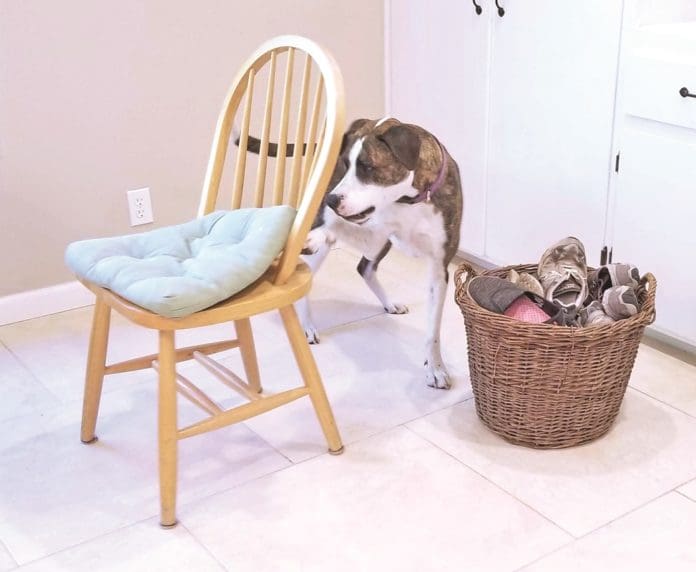



Using “search and find”, our dog will locate specific favorite toys of his. But the most useful search/find he does is locating our cat for me! This is very handy since, as cat owners know, sometimes a cat will go to an obscure place. When I can’t find the cat, I can say “Where is our kitty? Find the kitty!” And our dog will dash about, nose to the ground, and locate the cat. He then points to where the cat is!
I have a 7 mth old chi-weinnie that simply ignores all my commands
she just looks at me and continues what it is she is doing
the worse part is that she is extremely high, nervous energy all the time
if I say come she is more energized and want s to play “catch me if you can”, and runs around “devil may care”, ignoring traffic and cars
I tried getting her to take valerium, but no way …she is just out of control….
Those are common problems, and they can be addressed. Get a good force-free trainer and do her homework, and you will probably see a huge improvement!
New to training,,, however regarding the steps to teach search and find. Do ido these steps in stages ,, can I spread out first technique in early morning then build to second one afternoon then resume next day?. How to structure this,,?
How about “pairing” the object with food? Techniques that are already established dont need to be rewritten by you. And you dont think about converging odor(put lots out…its fun!) when you have a green dog, frustration is the main cause of dogs quitting. Please get a qualified instructor to write articles such as this. Too simplified for what you tried to convey.
Do you know of another step by step article? I felt this article was too condensed at the end. Do we reward the dog once they find it? Teaching a new command for locating it is difficult especially if we are to use that command again for them to come and notify us. My dog did the first part just fine with scent and search, but I need more step by step instructions on notification.
We call our game Go Find It and i use it at night to hide pieces of kibble around the house so my dog doesn’t go to bed on an empty tummy. She loves the game and it was not hard to teach it to her! The hardest part is the stay…she is so excited to get going that she just about follows me around while i hide it and then she picks it up!
I have four dogs and taking them all out together in the morning to do their toilets used to be a pain especially finding them ! Problem is now solved ! I have a clever Cockapoo, one day I just said to him where’s your Poo Poo Jake and he followed where he had been and then signalled by stopping by it and looking at me, he then gets a reward. He will also find the other dogs poo too !! No more hunting round for them, just call Jake !!
We took a nosework class a few years ago. My dog can find truffle scent (in the house, we haven’t graduated to outside) and birch scent hidden either in boxes or around the house … or the car! Great fun. Excellent step by step instructions in this article to grow the game. Thanks!
My deaf partially sighted rescue puppy, now a year old LOVES find it games, usually his tugger. When we play in the lounge & the timing is right & I do have to be quick to keep his tugger! I can throw my left arm up in the air & tell him find it ( not that he can hear me… he’s deaf) , I think it’s the action, breeze of my arm or shadow of my arm that sends him off on his mission, hall, kitchen, his crate, round the coffee table great fun.
Eventually 2-3 mins later I place it where he will sniff it out. Then it’s more play please & can we do it again as he chases all over 🐾🐾 🤗
After our blk lab goes outside for her nighttime potty break, I hide snacks whilst the husband is walking her around the yard. By the time she hits the back door, she’s raring to “go get ’em”. I began by hiding the snacks in a single room, but it didn’t take long before she graduated to having to cover the entire house. Yep. 5 snacks in 5 different rooms, all hidden under a stuffed animal.
I haven’t done very advanced nose work with my Pibble/Lab Vera yet, but a simple Find It! game has proved to be very useful and very fun for her. I started practicing long down-stays when we were at our local park, and she did very well. I had done a simple “Find It!” with her at home, just tossing a couple of treats in the brown shag carpeting (so they blended in).
Finally, I put the two together one day when I was having trouble getting Vera to leave the park. I had her go into a down-stay, walked a few yards in the direction of home, and instead of returning to her before giving her treats, I tossed a couple in the grass near me and said, Find it! She took off like a flash and found the treats quickly. Then I had her lie down again, gave the stay signal (stop sign hand) and walked another 10 yards or so, reminded her to stay, then tossed some treats and called, Find it! I accompany Find It! with a sweeping arm gesture in the rough direction of the treats. The grass hides treats well, so she has to use her nose to find them. (Sometimes I just toss one at a time.) I make a mental note of which clump of grass the treats are next to so I can tell whether she’s got them all or not. Before she knows it, Vera is at the edge of the park and doesn’t resist leaving and going home. So fun!
My 10 month old lab puppy is as smart as you can get. The very first time I did “find” in the yard he went right to hidden treats (kept him inside with my wife so he didn’t see where I hid them) and with very little effort went right to them in the yard. He knows “find!” because the nose goes to the ground right away the second I say it. I would love to know his “canine I.Q.”
I just found the article via Google and it helped me a lot. Thank you for your effort.
my three year old std poodle loves this game. he is very high energy and not the best eater. I supplement his food with a couple of sessions of Search! for various objects and he is great at it. It also does tire him if we do it for 10 or 15 minutes. he keeps him calm in the house. Now if only i could get him to settle down at our fence when a car drives by.
How can I teach my doodle to come when called
I did not receive an answer to my question about training my doodle to come when called
How can I teach our seventeen month old double doodle who is smart n so love able to come when called? She hears us calling and just continues doing her own thing.
This is exactly what i’m looking for. Thank you so much.
I can’t wait to try this with my terrier pup! He is a very energetic dog and he already “finds” his ball or play sock, he will probably LOVE this game! Thanks for the article :))